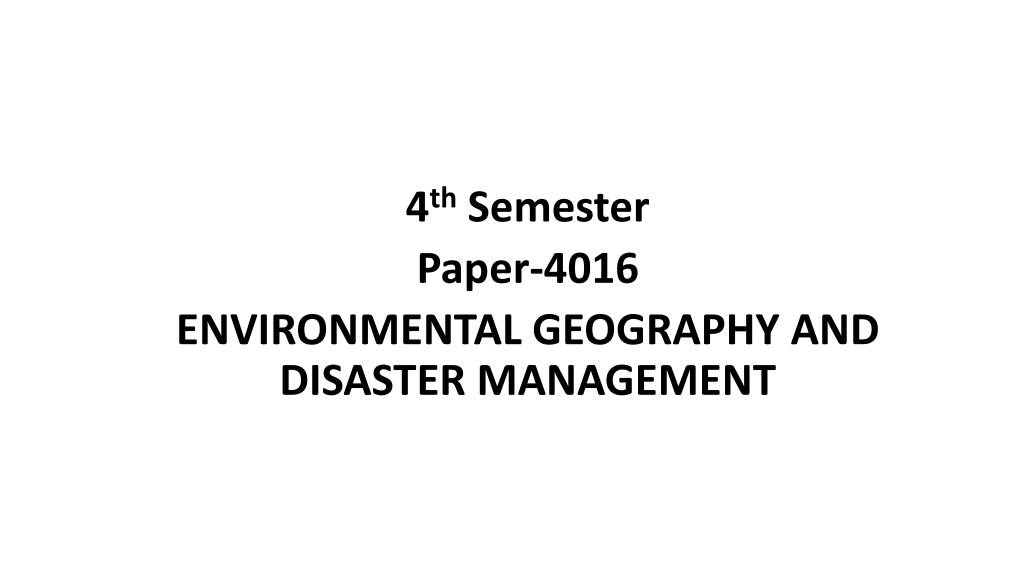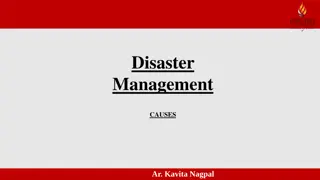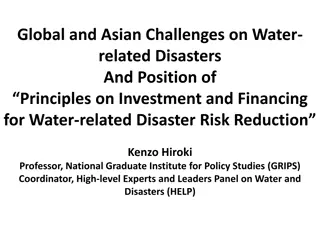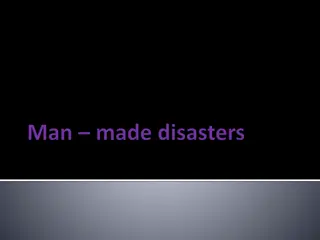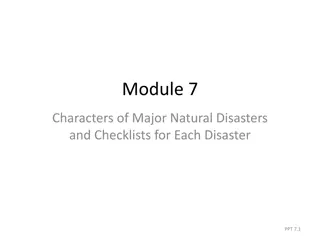Understanding Chemical Disasters in the Indian Chemical Industry
Chemical disasters pose a significant threat to the Indian chemical industry, impacting human lives, property, and the environment. Factors contributing to these disasters include ageing process plants, human errors, design defects, and natural events. Proper prevention measures, such as hazard identification, maintenance, and gas detection systems, are crucial to mitigating these risks. Collaboration between industry, government, and communities is essential for effective disaster management.
Download Presentation

Please find below an Image/Link to download the presentation.
The content on the website is provided AS IS for your information and personal use only. It may not be sold, licensed, or shared on other websites without obtaining consent from the author. Download presentation by click this link. If you encounter any issues during the download, it is possible that the publisher has removed the file from their server.
E N D
Presentation Transcript
4thSemester Paper-4016 ENVIRONMENTAL GEOGRAPHY AND DISASTER MANAGEMENT
CHEMICAL AND NUCLEAR EXPLOSION *CHEMICAL DISASTER The Indian chemical industry contributes 2.11% to country's GDP. Chemical, being at the core of modern industrial systems, has attained a very serious concern for disaster management within government, private sector and community at large. Chemical disasters may be traumatic in their impacts on human beings and have resulted in the casualties and also damages nature and property. The elements which are at highest risks due to chemical disaster primarily include the industrial plant, its employees & workers, hazardous chemicals vehicles, the residents of nearby settlements, adjacent buildings, occupants and surrounding community.
Chemical disasters are occurrence of emission, fire or explosion involving one or more hazardous chemicals in the course of industrial activity i.e. handling storage or transportation or due to natural events. The Ministry of Environment and Forest (MoEF) is the nodal ministry for the management of chemical disasters and NDMA prepares guidelines for the various ministries and state authorities for the preparation of disaster management plans. Factors Which Cause Chemical Disaster 1. Ageing of the process plants and inadequate steps to pace with modern technologies in Indian chemical industry has increased vulnerability to chemical disasters. 2. A majority of the industrial accidents occurs due to human errors, as a result of non-compliance with standard operating procedure (SOP's) that have been put into place by the company. Ex: Piper alpha accident is a classic example of human error caused disaster. 3. Chemical disaster have also occurred due to defects in design; absence of SOP's to mitigate an early warning in the process, poor co-ordination between different departments within the chemical company.
4. Natural disasters such as flood and earthquakes have also caused major disasters in chemical industry. The release of acrylonitrile at Kandla Port in Gujarat, during an earthquake in 2001, is one of the examples. 5. Irregular improper maintenance of equipments in chemical industry, due to this equipment gets malfunction and ultimately fails, resulting in catastrophic explosion. The Flixborough incident is a prime example of improper maintenance which lead to the death of 28 people and injured many. Prevention and Response 1. Role of Industry a) Identification of hazardous activities: A knowledgeable and dedicated team of qualified professionals to evaluate the hazards and risks arising from day to day activities is essential. Use of appropriate hazard identifications tools such as checklists analysis, safety audit, HAZOP etc. would help in mitigating hazards.
b) Maintenance of the Plant Facility & Equipment: Proper maintenance, regular site safety and health inspection need to be carried out to ensure that plant facility is safe and equipments are operating in intended method. c) Installation of Vapour/Gas Detection System: This with alarms will help to detect leak even at micro levels, and ensure that leaks are attended at the early stage. d) Compliance with existing rules and regulations: Various rules and regulation of the state and centre should be strictly addressed for a sustainable & safe process. e) Emergency preparedness: The industry must have a good emergency response team that can react swiftly to mitigate propagating disasters.
2. Role of Government a) Setting up of accident investigation board and chemicals accident data base: An accident investigation board on similar lines of chemical safety boards of USA can be setup in India to investigate the chemical disasters and bring out guideline based on lessons learnt. An online portal, where experts from around the world can help industries to prevent such unforeseen circumstances. b) Awareness Campaigns: Frequent mock drills need to be conducted so that workers become adequately knowledgeable to react to emergency. c) Research & Development: Research and Development to develop newer technologies so that toxicity of by-products of chemical industries can be minimised d) Offsite Emergency Planning: The purpose of offsite emergency plans is to ensure that the local authority adequately discharges his duty to minimize the consequences of major accident to people and environment in MAH located sites
e) Emergency Response During Transportation: Swift and timely availability of emergency response for disaster during transportation of hazardous materials/chemicals. For this Indian Chemical Council (ICC) has initiated a program called "Nicerglobe" which provides GPRS tracking of trucks right from origin to the place of destination. 3) Role of Public A general awareness of risk associated with any chemical accident would help in reducing the outcome of the accident. A mutual aid group can be setup to organise the general public in case of any disaster & provide training and awareness about the potential action to be taken in case of any chemical leakage.
Status of Chemical Disaster Risk in India India has witnessed the world s worst chemical (industrial) disaster Bhopal Gas Tragedy in the year 1984. The Bhopal Gas tragedy was most devastating chemical accident in history, where over 2500 people died due to accidental release of toxic gas Methyl Iso Cyanate (MIC). Such accidents are significant in terms of injuries, pain, suffering, loss of lives, damage to property and environment. India continued to witness a series of chemical accidents even after Bhopal had demonstrated the vulnerability of the country. Safety initiatives taken in India to address chemical risk The comprehensive legal/ institutional framework exists in our country. A number of regulations covering the safety in transportation, liability, insurance and compensations have been enacted.
Following are the relevant provisions on chemical disaster management, prevailing in country:- Explosives Act 1884-Petroleum Act 1934 Factories Act 1948-Insecticides Act 1968 Environment Protection Act 1986-Motor Vehicles Act 1988 Public Liability Insurance Act 1991-Disaster Management Act 2005 Government of India has further reinforced the legal framework on chemical safety and management of chemical accidents by enacting new rules The National Disaster Management Authority (NDMA) of India had come out with very specific guidelines on Chemical Disaster Management. The guidelines have been prepared to provide the directions to ministries, departments and state authorities for the preparation of their detailed disaster management plans
These guidelines call for a proactive, participatory, multi-disciplinary and multi-sectoral approach at various levels for chemical disaster preparedness and response Precautions to be taken during and after the Chemical (Industrial) Accidents Do not panic, evacuate calmly and quickly perpendicular to wind direction through the designated escape route Keep a wet handkerchief or piece of cloth/ sari on face during evacuation Keep the sick, elderly, weak, handicapped and other people who are unable to evacuate inside house and close all the doors and windows tightly. Do not consume the uncovered food/ water etc open to the air, drink only from bottle Change into fresh clothing after reaching safe place/ shelter, and wash hands properly. Inform Fire & Emergency Services, Police and medical services from safe location by calling 101, 100 and 108 respectively.
Listen to PA (Public Addressal) System of the plant/ factory, local radio/ TV channels for advice from district administration/fire/health/police and other concerned authorities Provide correct and accurate information to government official. Inform others on occurrence of event at public gathering places (like school, shopping centre, theatre etc.). Don t pay attention to the rumours and don t spread rumours. General Precautions During Normal Time Do not smoke, lit fire or spark in the identified hazardous area Sensitize the community living near the industrial units and they should be more vigilant about the nature of industrial units and associated risks.
Keep the contact numbers of nearest hazardous industry, fire station, police station, control room, health services and district control room, for emergency use. Avoid housing near the industries producing or processing the hazardous chemicals, if possible. Participate in all the capacity building programmes organized by the government/ voluntary organizations / industrial units. Take part in preparing disaster management plan for the community and identify safe shelter along with safe and easy access routes. Prepare a family disaster management plan and explain it to all the family members. Make the family/ neighbours aware of the basic characteristics of various poisonous/ hazardous chemicals and the first aid required to treat them.
Adequate number of personal protective equipments needs to be made available, to deal with emergency situation. Prepare an emergency kit of items and essentials in the house, including medicines, documents and valuables Disaster is a rarity in the chemical industry, but negligence or misfortune can so easily result in devastating consequences. The result of a chemical disaster has effects through generations of populations which are almost irreparable and the cost of that to the affected people is unimaginable. Source- National Disaster Management Authority (NDMA), Government of India Wikipedia NCERT Alaka Gautam-Environmental geography
